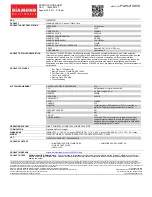
©
National Instruments Corporation
5
Getting Started with the NI PCI-8252
Operating relative humidity ...................................20% to 80%, noncondensing
Pollution Degree ....................................................2
Measurement Category ..........................................I
Caution
Do
not
use the NI 8252 for connection to signals within Measurement Categories II, III,
or IV.
Approved at altitudes up to 2,000 m.
Storage Environment
Ambient temperature range ...................................–20 °C to 60 °C
Relative humidity...................................................20% to 95%, noncondensing
Safety
This product is designed to meet the requirements of the following standards of safety for electrical
equipment for measurement, control, and laboratory use:
•
IEC 61010-1, EN 61010-1
•
UL 61010-1, CSA 61010-1
Note
For UL and other safety certifications, refer to the product label or visit
ni.com/
certification
, search by model number or product line, and click the appropriate link
in the Certification column.
Electromagnetic Compatibility
This product is designed to meet the requirements of the following standards of EMC for electrical
equipment for measurement, control, and laboratory use:
•
EN 61326 EMC requirements; Minimum Immunity
•
EN 55011 Emissions; Group 1, Class A
•
CE, C-Tick, ICES, and FCC Part 15 Emissions; Class A
Note
For EMC compliance, operate this device according to product documentation.
CE Compliance
This product meets the essential requirements of applicable European Directives, as amended for
CE marking, as follows:
•
73/23/EEC; Low-Voltage Directive (safety)
•
89/336/EEC; Electromagnetic Compatibility Directive (EMC)
Note
Refer to the Declaration of Conformity (DoC) for this product for any additional regulatory
compliance information. To obtain the DoC for this product, visit
ni.com/certification
,
search by model number or product line, and click the appropriate link in the Certification column.
Waste Electrical and Electronic Equipment (WEEE)
EU Customers
At the end of their life cycle, all products
must
be sent to a WEEE recycling center.
For more information about WEEE recycling centers and National Instruments WEEE initiatives,
visit
ni.com/environment/weee.htm
.

























